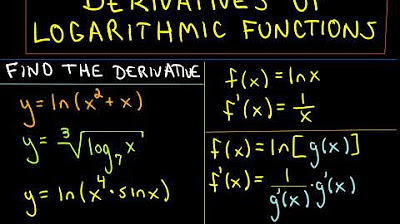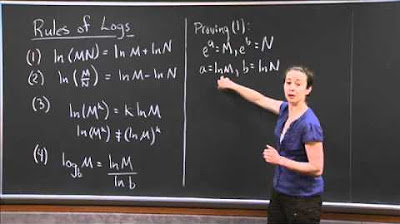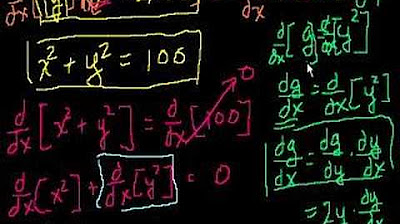Logarithmic Differentiation
TLDRThis video explores logarithmic differentiation, a technique used to find derivatives of functions like \( x^x \) and \( \sqrt{x}^{\sin x} \). It involves using logarithmic properties to transform the function and then applying implicit differentiation. The presenter also discusses general derivative rules for exponential functions.
Takeaways
- 📘 Logarithmic differentiation is an extension from AP Calculus, often taught in Calculus I courses.
- 📏 The property log(base^exponent) = exponent * log(base) is crucial for logarithmic differentiation.
- ✍️ Logarithmic differentiation is especially useful for functions of the form f(x)^g(x).
- 📐 To find the derivative of x^x, use logarithmic differentiation by taking the natural log of both sides.
- 🔍 The derivative of x^x is x^x * (1 + log(x)).
- 📊 Another example is finding the derivative of √x^sin(x) using logarithmic differentiation.
- 🧮 Logarithmic differentiation involves taking the natural log of both sides and then differentiating implicitly.
- 📚 The final derivative for √x^sin(x) is derived through several steps, involving trigonometric and logarithmic properties.
- 🔢 Knowing logarithmic differentiation, along with AP Calculus techniques, allows for the differentiation of all closed-form functions.
- 📝 Summary of exponential derivative rules: a^b = 0, x^a = a*x^(a-1), a^x = a^x * log(a), and x^x = x^x * (1 + log(x)).
Q & A
What is the main topic of the video?
-The main topic of the video is logarithmic differentiation, an extension from AP Calculus that is commonly taught in Calculus One courses.
Why is logarithmic differentiation not tested on the AP exam?
-Logarithmic differentiation is not tested on the AP exam because it is considered an advanced topic beyond the standard curriculum.
What is the significance of the logarithmic property mentioned in the video?
-The logarithmic property mentioned allows the exponent of a logarithm to be moved in front of the logarithm and multiplied, which is crucial for logarithmic differentiation.
How is the derivative of x to the x power approached in the video?
-The derivative of x to the x power is approached by first applying a logarithmic property to rewrite the function, then differentiating implicitly with respect to x.
What is the derivative of the natural log of y with respect to x?
-The derivative of the natural log of y with respect to x is 1/y times dy/dx, following the chain rule.
How is the derivative of x to the x power simplified in the video?
-The derivative is simplified by multiplying both sides of the equation by y, which is equal to x to the x, to eliminate y from the equation.
What is the second example function differentiated in the video?
-The second example function is the square root of x to the sine of x power.
Why is logarithmic differentiation particularly useful for functions of the form f(x) to the g(x) power?
-Logarithmic differentiation is useful for functions of the form f(x) to the g(x) power because it allows for the simplification of complex derivatives when both the base and the exponent are functions of x.
What is the final expression for the derivative of x to the x power in terms of x?
-The final expression for the derivative of x to the x power is x to the x times (1 + the natural log of x).
What are the general derivative rules for exponential functions discussed in the video?
-The general derivative rules for exponential functions discussed are the derivatives of a to the b, x to the a power, a to the x, and x to the x power, each with its respective formula.
How does the video conclude the discussion on derivatives of exponential functions?
-The video concludes by summarizing the derivative rules for different combinations of exponential functions and emphasizing that knowing logarithmic differentiation and AP calculus techniques allows one to find derivatives of any function expressed in terms of x.
Outlines
🔢 Introduction to Logarithmic Differentiation
The video introduces logarithmic differentiation, an advanced calculus topic not covered in the AP Calculus exam but common in Calculus I courses. The speaker emphasizes the importance of a specific logarithm property, which allows exponents to be manipulated as multipliers. This concept is crucial for understanding the relationship between exponents and logarithms. The speaker sets up the context by explaining this property before diving into derivative problems involving logarithmic differentiation.
📈 Example 1: Derivative of x to the x Power
The first example demonstrates how to find the derivative of the function x^x. The process involves applying the logarithm property to simplify the function before differentiation. By taking the natural logarithm of both sides and using implicit differentiation, the speaker derives the expression for the derivative. The final result is presented as x^x times (1 + ln(x)), showing the effectiveness of logarithmic differentiation for such functions.
🧮 Example 2: Derivative of sqrt(x) to the sin(x) Power
In the second example, the speaker tackles the derivative of sqrt(x) raised to the power of sin(x). This function requires a similar approach, using logarithmic properties to simplify the expression before differentiating. By taking the natural logarithm of both sides and applying the chain rule, the speaker derives the expression for the derivative. The final result involves a combination of trigonometric and logarithmic functions, highlighting the versatility of logarithmic differentiation for complex expressions.
📊 Summary of Derivative Rules for Exponential Scenarios
The video concludes with a summary of derivative rules for different exponential functions. The speaker reviews the derivatives of a^b (constant), x^a (power rule), a^x (exponential rule), and x^x (requiring logarithmic differentiation). This comprehensive overview ties together the different methods and rules discussed, reinforcing the understanding of how to handle various types of exponential functions in calculus. The session wraps up with a reminder of the utility of logarithmic differentiation in simplifying complex derivatives.
Mindmap
Keywords
💡Logarithmic Differentiation
💡Log Property
💡Natural Logarithm
💡Implicit Differentiation
💡Chain Rule
💡Exponential Function
💡Power Rule
💡Derivative
💡Constant
💡AP Calculus
Highlights
Introduction to logarithmic differentiation, an extension from AP Calculus.
Emphasis on a specific log property crucial for logarithmic differentiation.
Explanation of the log property: log base to the power of exponent can be rearranged.
Derivative of x to the power of x, a function not commonly covered in AP Calculus.
Use of the natural log to transform the function x to the power of x before differentiation.
Implicit differentiation applied to the transformed equation.
Derivative of natural log of y with respect to x is 1/y * dy/dx.
Derivative of x with respect to x is 1, and derivative of log x is 1/x.
Solving for dy/dx by multiplying both sides by y.
Derivative of x to the power of x is x to the x times (1 + log of x).
Introduction of the derivative of square root of x to the sine of x.
Technique of logarithmic differentiation is most helpful for functions of the form f(x) to the g(x) power.
Transformation of the function using natural log and the log property.
Derivative of sine of x and log of square root of x with respect to x.
Simplification of the derivative expression by combining terms.
Final expression for the derivative of square root of x to the sine of x.
Discussion on derivative rules for exponential scenarios involving a to the b, x to the a, a to the x, and x to the x.
Derivative of a to the b is zero, derivative of x to the a power is a * x^(a-1).
Derivative of a to the x is a^x times the natural log of a.
Derivative of x to the x requires logarithmic differentiation and is x^x times (1 + log x).
Conclusion on the ability to derive any function in closed form if you know logarithmic differentiation and AP calculus techniques.
Transcripts
Browse More Related Video

Logarithmic Differentiation | Example: x^sinx

Derivatives of Exponential Functions & Logarithmic Differentiation Calculus lnx, e^2x, x^x, x^sinx

Derivatives of Logarithmic Functions - More Examples

Rules of Logs | MIT 18.01SC Single Variable Calculus, Fall 2010

Derivatives of Log Functions

Implicit Differentiation
5.0 / 5 (0 votes)
Thanks for rating: